Solar Photovoltaic Panels with Finned Phase Change Material Heat Sinks
Abstract
:1. Introduction
2. Systems Description
3. Methodology
3.1. Thermal Analysis
3.2. Boundary Conditions
3.3. Initial Conditions
3.4. Power Production
4. Validation
5. Results and Discussion
5.1. PV Temperature
5.2. Temperature Contours
5.3. Power Production
5.4. Electrical Efficiency
5.5. Daily Electricity Generation
5.6. Cost Analysis
5.7. Use of Extracted Heat
6. Conclusions
- The PCM heat sink can reduce the peak PV temperature by 13 K and the FPCM heat sink can reduce the PV temperature to 19 K.
- The PCM heat sink can increase the peak PV power output by 0.2 kW whereas the FPCM heat sink can enhance the power production by 0.3 kW.
- Instantaneous PV electrical efficiency during noon increases from 13% to 14% using PCM heat sinks.
- The daily electricity generation increases by 7% using PCM and 8% by using FPCM.
- Using the FPCM heat sink, 7 kWh of thermal output is achieved, and the overall efficiency of the PV system is increased from 13% to 19%.
Author Contributions
Funding
Conflicts of Interest
Appendix A
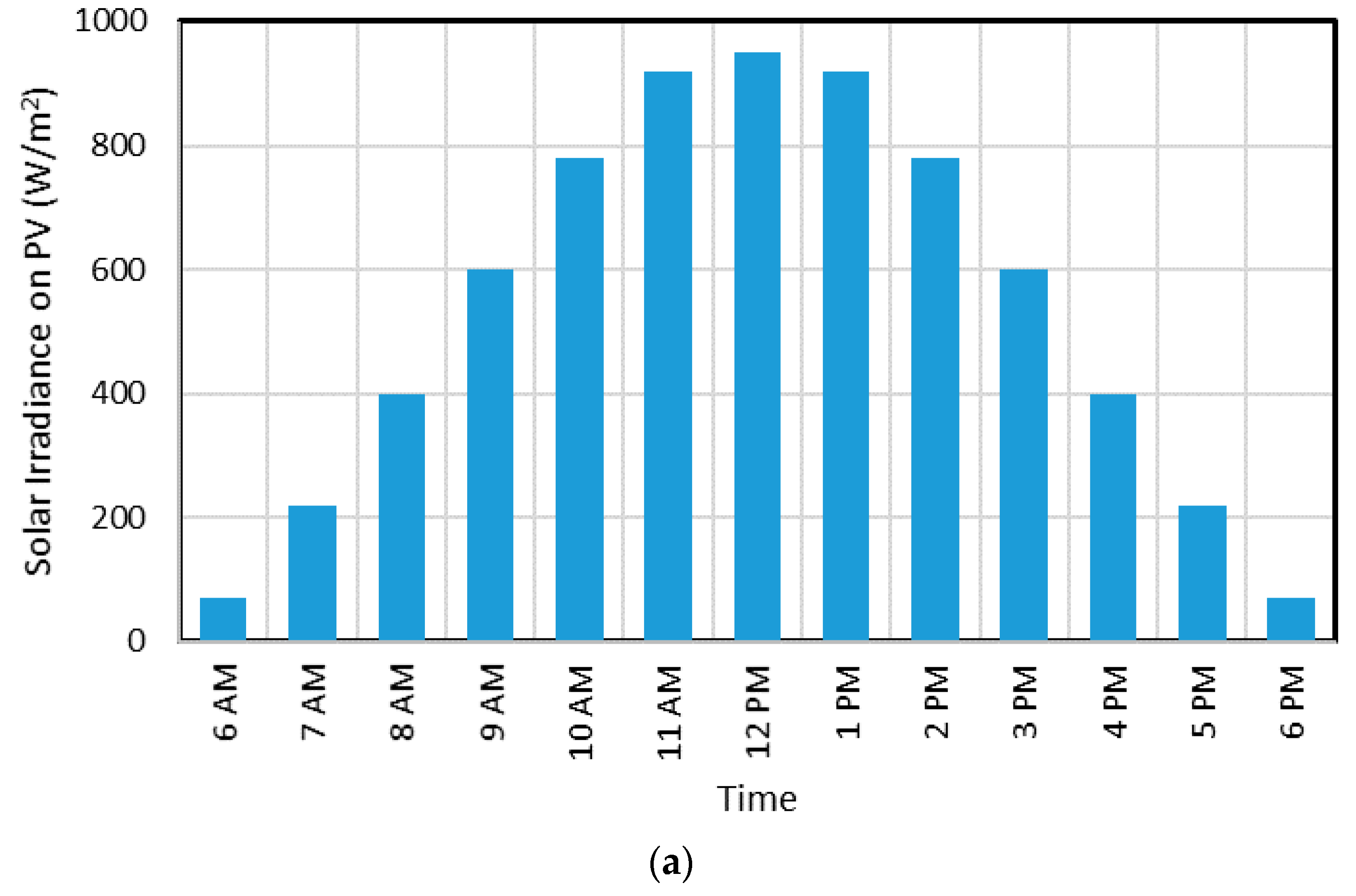
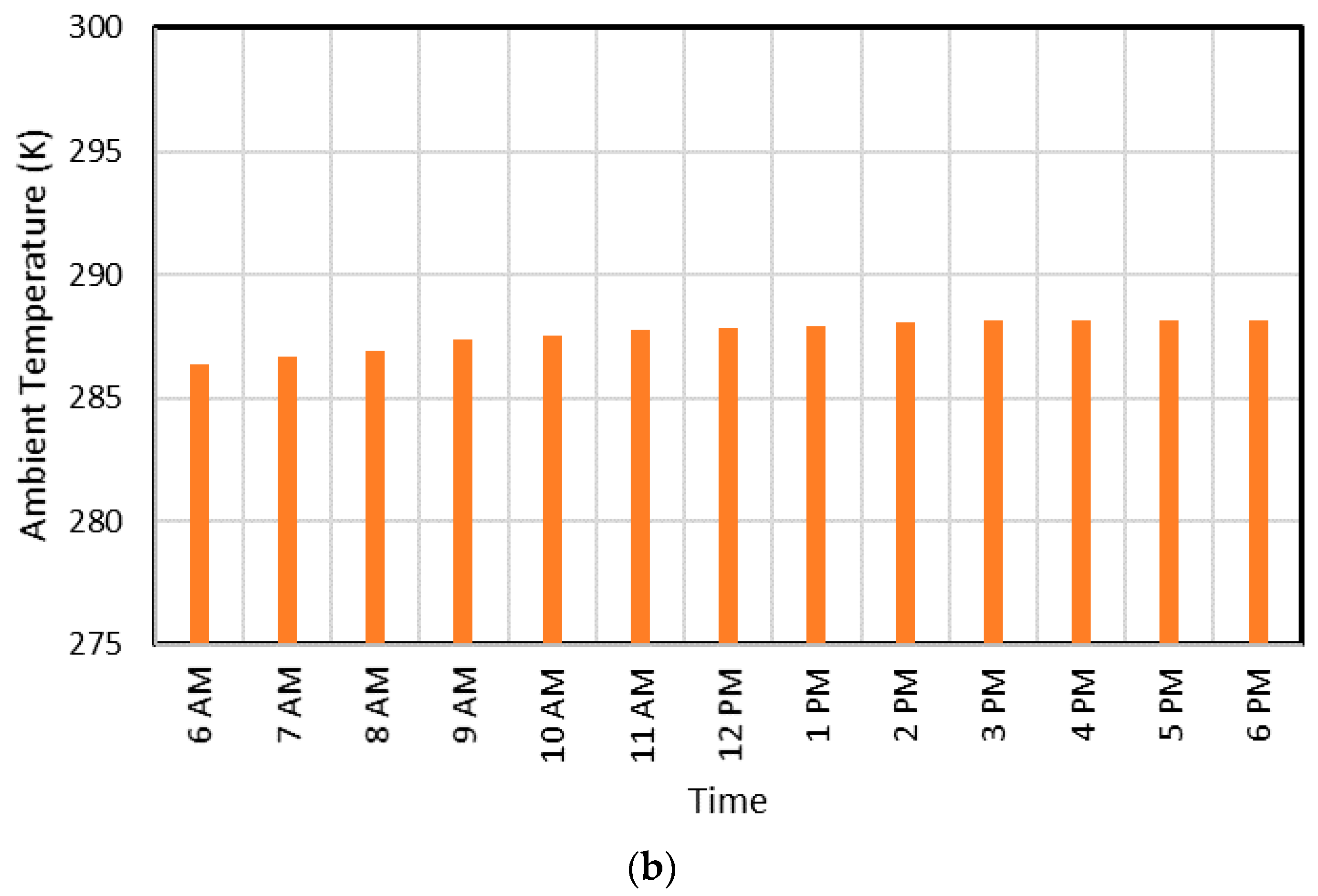
References
- Reddy, K.S.; Mudgal, V.; Mallick, T.K. Thermal performance analysis of multi-phase change material layer-integrated building roofs for energy efficiency in built-environment. Energies 2017, 10, 1367. [Google Scholar] [CrossRef] [Green Version]
- Elavarasan, R.M.; Velmurugan, K.; Subramaniam, U.; Kumar, A.R.; Almakhles, D. Experimental investigations conducted for the characteristic study of OM29 phase change material and its incorporation in photovoltaic panel. Energies 2020, 13, 897. [Google Scholar] [CrossRef] [Green Version]
- Al Siyabi, I.; Khanna, S.; Sundaram, S.; Mallick, T. Experimental and numerical thermal analysis of multi-layered microchannel heat sink for concentrating photovoltaic application. Energies 2019, 12, 122. [Google Scholar] [CrossRef] [Green Version]
- Sajjad, U.; Amer, M.; Ali, M.H.; Dahiya, A.; Abbas, N. Cost effective cooling of photovoltaic modules to improve efficiency. Case Stud. Therm. Eng. 2019, 14, 100420. [Google Scholar] [CrossRef]
- Kasaeian, A.; Khanjari, Y.; Golzari, S.; Mahian, O.; Wongwises, S. Effects of forced convection on the performance of a photovoltaic thermal system: An experimental study. Exp. Therm. Fluid Sci. 2017, 85, 13–21. [Google Scholar] [CrossRef]
- Barone, G.; Buonomano, A.; Forzano, C.; Palombo, A.; Panagopoulos, O. Photovoltaic thermal collectors: Experimental analysis and simulation model of an innovative low-cost water-based prototype. Energy 2019, 179, 502–516. [Google Scholar] [CrossRef]
- Yang, L.H.; Liang, J.D.; Hsu, C.Y.; Yang, T.H.; Chen, S.L. Enhanced efficiency of photovoltaic panels by integrating a spray cooling system with shallow geothermal energy heat exchanger. Renew. Energy 2019, 134, 970–981. [Google Scholar] [CrossRef]
- Nizetic, S.; Coko, D.; Yadav, A.; Cabo, F.G. Water spray cooling technique applied on a photovoltaic panel: The performance response. Energy Convers. Manag. 2016, 108, 287–296. [Google Scholar] [CrossRef]
- Yuan, W.; Ji, J.; Li, Z.; Zhou, F.; Ren, X.; Zhao, X.; Liu, S. Comparison study of the performance of two kinds of photovoltaic/thermal(PV/T) systems and a PV module at high ambient temperature. Energy 2018, 148, 1153–1161. [Google Scholar] [CrossRef]
- Shahsavar, A.; Ameri, M.; Gholampour, M. Energy and exergy analysis of a Photovoltaic-Thermal collector with natural air flow. J. Sol. Energy Eng. 2012, 134, 1–10. [Google Scholar] [CrossRef]
- Parkunam, N.; Lakshmanan, P.; Navaneethakrishnan, G.; Arul, S.; Vijayan, V. Experimental analysis on passive cooling of photovoltaic panel with heat sink and wick structure. Energy Sources 2020, 42, 653–663. [Google Scholar]
- Wu, S.Y.; Zhang, Y.C.; Xiao, L.; Shen, Z.G. Performance comparison investigation on solar photovoltaic-thermoelectric generation and solar photovoltaic-thermoelectric cooling hybrid systems under different conditions. Int. J. Sustain. Energy 2018, 37, 533–548. [Google Scholar] [CrossRef]
- Reddy, K.S.; Mudgal, V.; Mallick, T.K. Review of latent heat thermal energy storage for improved material stability and effective load management. J. Energy Storage 2018, 15, 205–227. [Google Scholar] [CrossRef]
- Huang, M.J.; Eames, P.C.; Norton, B. Phase change materials for limiting temperature rise in building integrated photovoltaics. Sol. Energy 2006, 80, 1121–1130. [Google Scholar] [CrossRef]
- Huang, M.J.; Eames, P.C.; Norton, B. Thermal regulation of building-integrated photovoltaics using phase change materials. Int. J. Heat Mass Transf. 2004, 47, 2715–2733. [Google Scholar] [CrossRef]
- Atkin, P.; Farid, M.M. Improving the efficiency of photovoltaic cells using PCM infused graphite and aluminium fins. Sol. Energy 2015, 114, 217–228. [Google Scholar] [CrossRef]
- Khanna, S.; Reddy, K.S.; Mallick, T.K. Effect of climate on electrical performance of finned phase change material integrated solar photovoltaic. Sol. Energy 2018, 174, 593–605. [Google Scholar] [CrossRef]
- Hasan, A.; McCormack, S.J.; Huang, M.J.; Sarwar, J.; Norton, B. Increased photovoltaic performance through temperature regulation by phase change materials: Materials comparison in different climates. Sol. Energy 2015, 115, 264–276. [Google Scholar] [CrossRef]
- Hasan, A.; McCormack, S.J.; Huang, M.J.; Norton, B. Evaluation of phase change materials for thermal regulation enhancement of building integrated photovoltaics. Sol. Energy 2010, 84, 1601–1612. [Google Scholar] [CrossRef] [Green Version]
- Khanna, S.; Newar, S.; Sharma, V.; Reddy, K.S.; Mallick, T.K.; Radulovic, J.; Khusainov, R.; Hutchinson, D.; Becerra, V. Electrical enhancement period of solar photovoltaic using phase change material. J. Clean. Prod. 2019, 221, 878–884. [Google Scholar] [CrossRef] [Green Version]
- Singh, P.; Khanna, S.; Becerra, V.; Newar, S.; Sharma, V.; Mallick, T.K.; Hutchinson, D.; Radulovic, J.; Khusainov, R. Power improvement of finned solar photovoltaic phase change material system. Energy 2020, 193, 116735. [Google Scholar] [CrossRef]
- Rabie, R.; Emam, M.; Ookawara, S.; Ahmed, M. Thermal management of concentrator photovoltaic systems using new configurations of phase change material heat sinks. Sol. Energy 2019, 183, 632–652. [Google Scholar] [CrossRef]
- Siyabi, I.A.; Khanna, S.; Mallick, T.; Sundaram, S. An experimental and numerical study on the effect of inclination angle of phase change materials thermal energy storage system. J. Energy Storage 2019, 23, 57–68. [Google Scholar] [CrossRef]
- Indartono, Y.S.; Suwono, A.; Pratama, F.Y. Improving photovoltaics performance by using yellow petroleum jelly as phase change material. Int. J. Low Carbon Technol. 2014. [Google Scholar] [CrossRef] [Green Version]
- Biwole, P.H.; Eclache, P.; Kuznik, F. Phase-change materials to improve solar panel’s performance. Energy Build. 2013, 62, 59–67. [Google Scholar] [CrossRef]
- Souayfane, F.; Biwole, P.H.; Fardoun, F. Melting of a phase change material in presence of natural convection and radiation: A simplified model. Appl. Therm. Eng. 2018, 130, 660–671. [Google Scholar] [CrossRef]
- Aelenei, L.; Pereira, R.; Gonçalves, H.; Athienitis, A. Thermal performance of a hybrid BIPV-PCM: Modeling, design and experimental investigation. Energy Procedia 2014, 48, 474–483. [Google Scholar] [CrossRef] [Green Version]
- Sardarabadi, M.; Passandideh-Fard, M.; Maghrebi, M.; Ghazikhani, M. Experimental study of using both ZnO/water nanofluid and phase change material (PCM) in photovoltaic thermal systems. Sol. Energy Mater. Sol. Cells 2017, 161, 62–69. [Google Scholar] [CrossRef]
- Browne, M.C.; Lawlor, K.; Kelly, A.; Norton, B.; McCormack, S.J. Indoor characterisation of a photovoltaic/thermal phase change material system. Energy Procedia 2015, 70, 163–171. [Google Scholar] [CrossRef] [Green Version]
- Preet, S.; Bhushan, B.; Mahajan, T. Experimental investigation of water based photovoltaic/thermal (PV/T) system with and without phase change material (PCM). Sol. Energy 2017, 155, 1104–1120. [Google Scholar] [CrossRef]
- Khanna, S.; Newar, S.; Sharma, V.; Reddy, K.S.; Mallick, T.K. Optimization of fins fitted phase change material equipped solar photovoltaic under various working circumstances. Energy Convers. Manag. 2019, 180, 1185–1195. [Google Scholar] [CrossRef]
- Huang, M.J.; Eames, P.C.; Norton, B. Comparison of predictions made using a new 3D phase change material thermal control model with experimental measurements and predictions made using a validated 2D model. Heat Transf. Eng. 2007, 28, 31–37. [Google Scholar] [CrossRef]
- US Deparment of Energy. Available online: https://www.google.com/url?q=https://www.nrel.gov/docs/fy13osti/55553.pdf&sa=U&ved=2ahUKEwj34vmV5rbpAhVVilwKHQ0yARUQFjABegQIARAB&usg=AOvVaw0EfJU3M1m-KZdPoNbaJDKA (accessed on 17 May 2020).
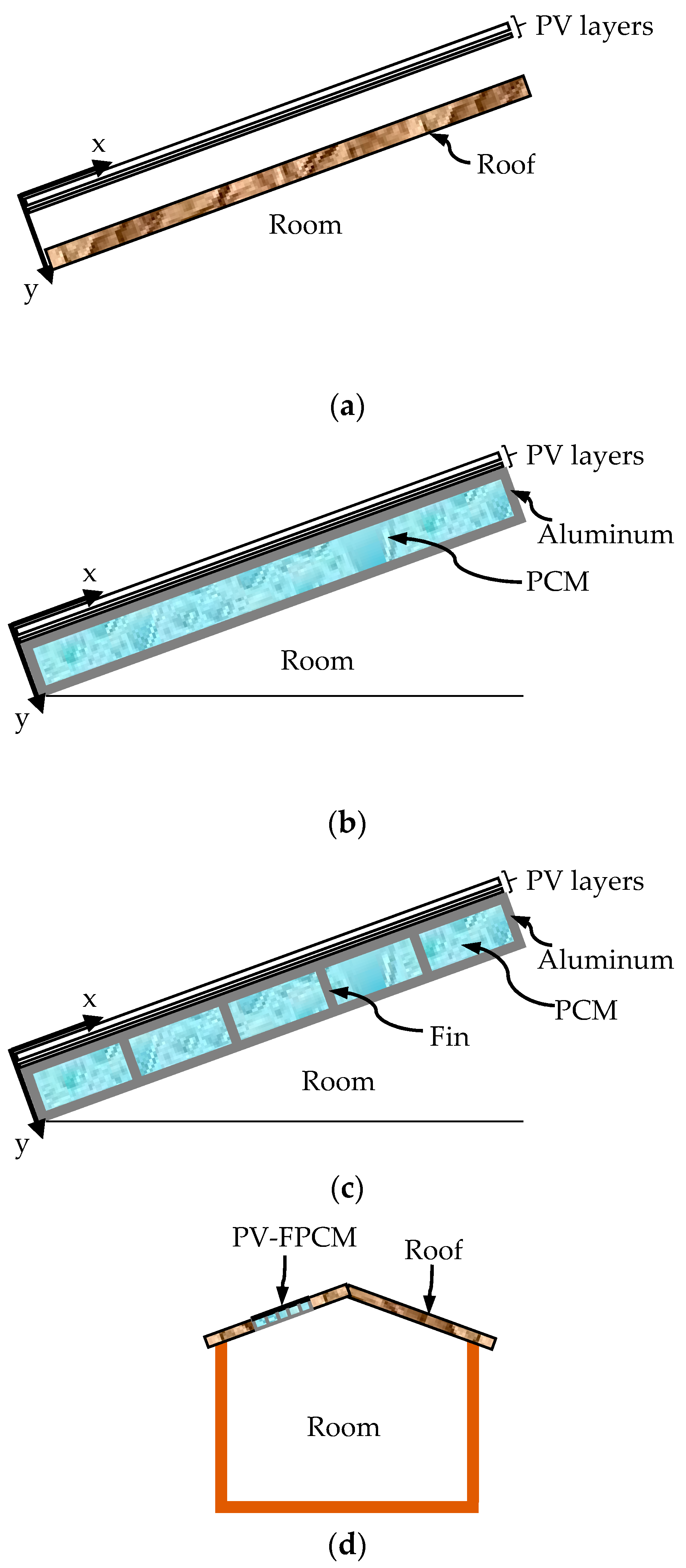
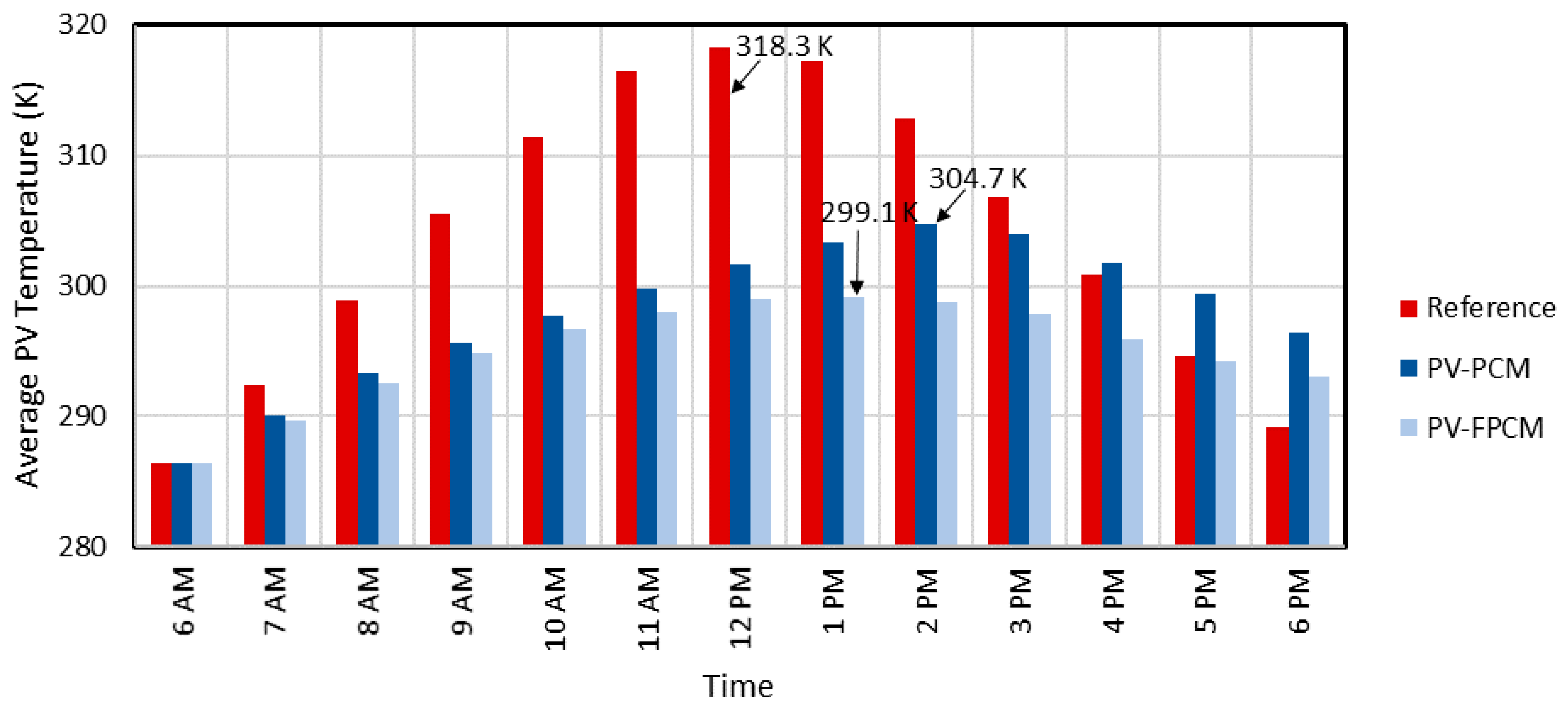
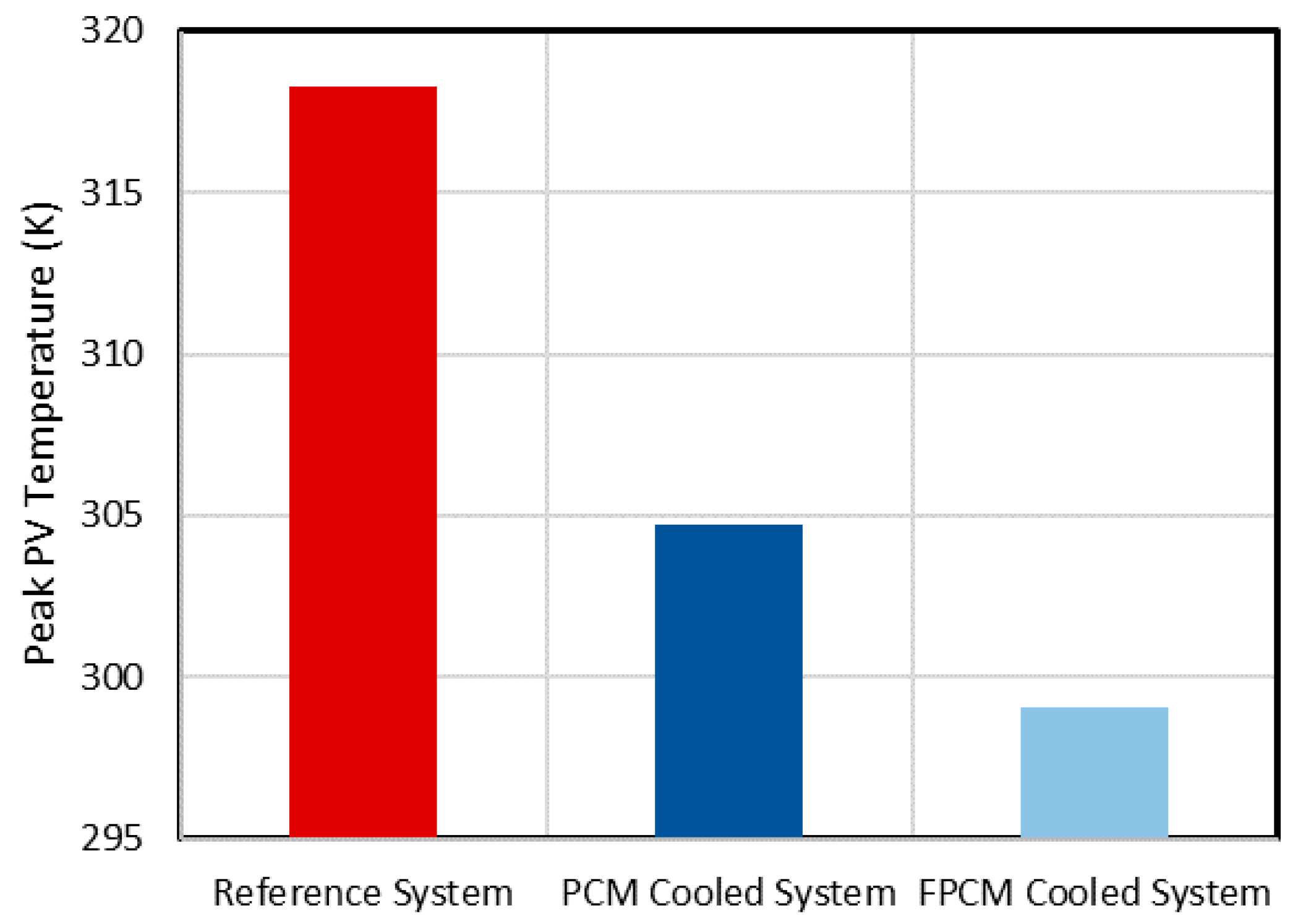
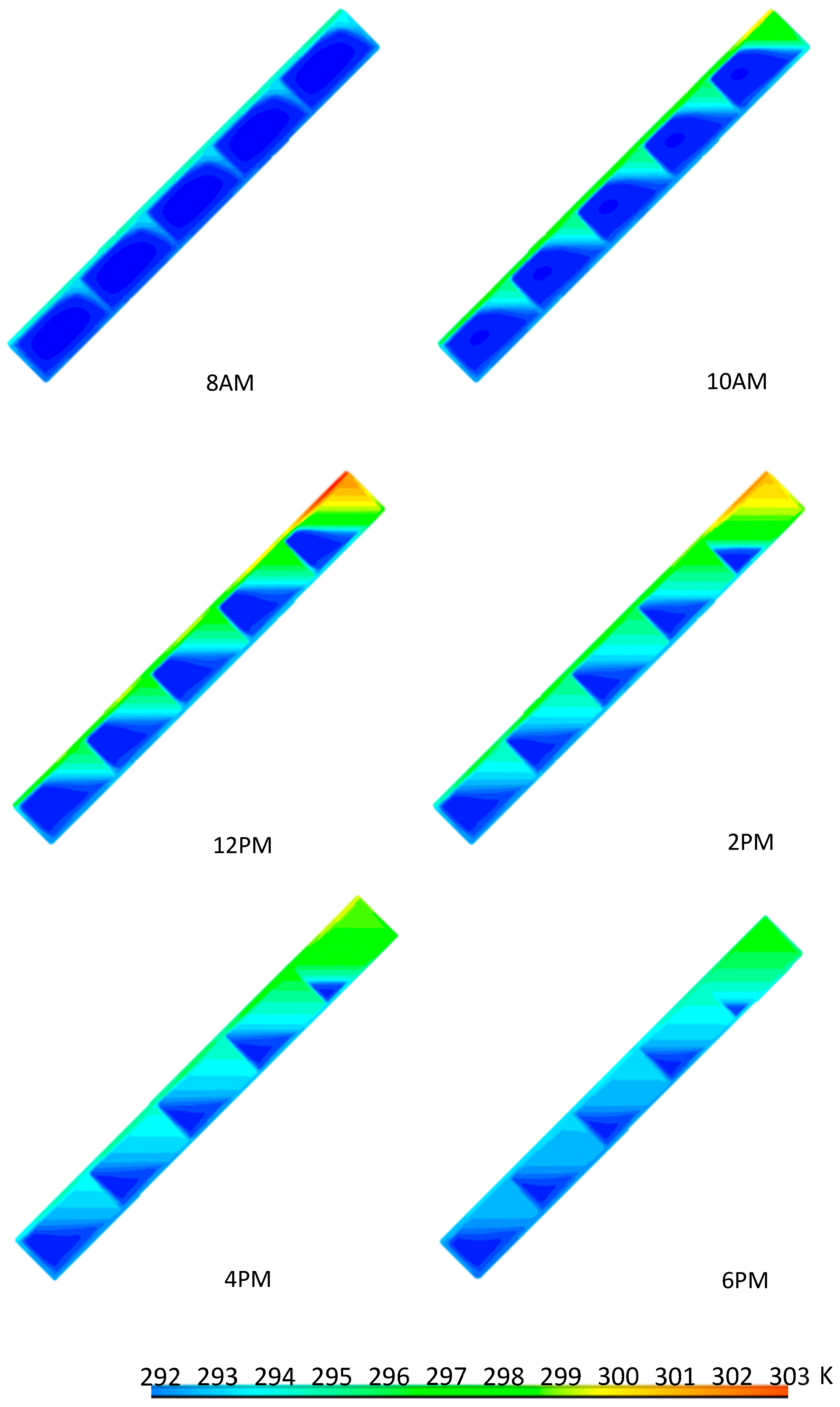


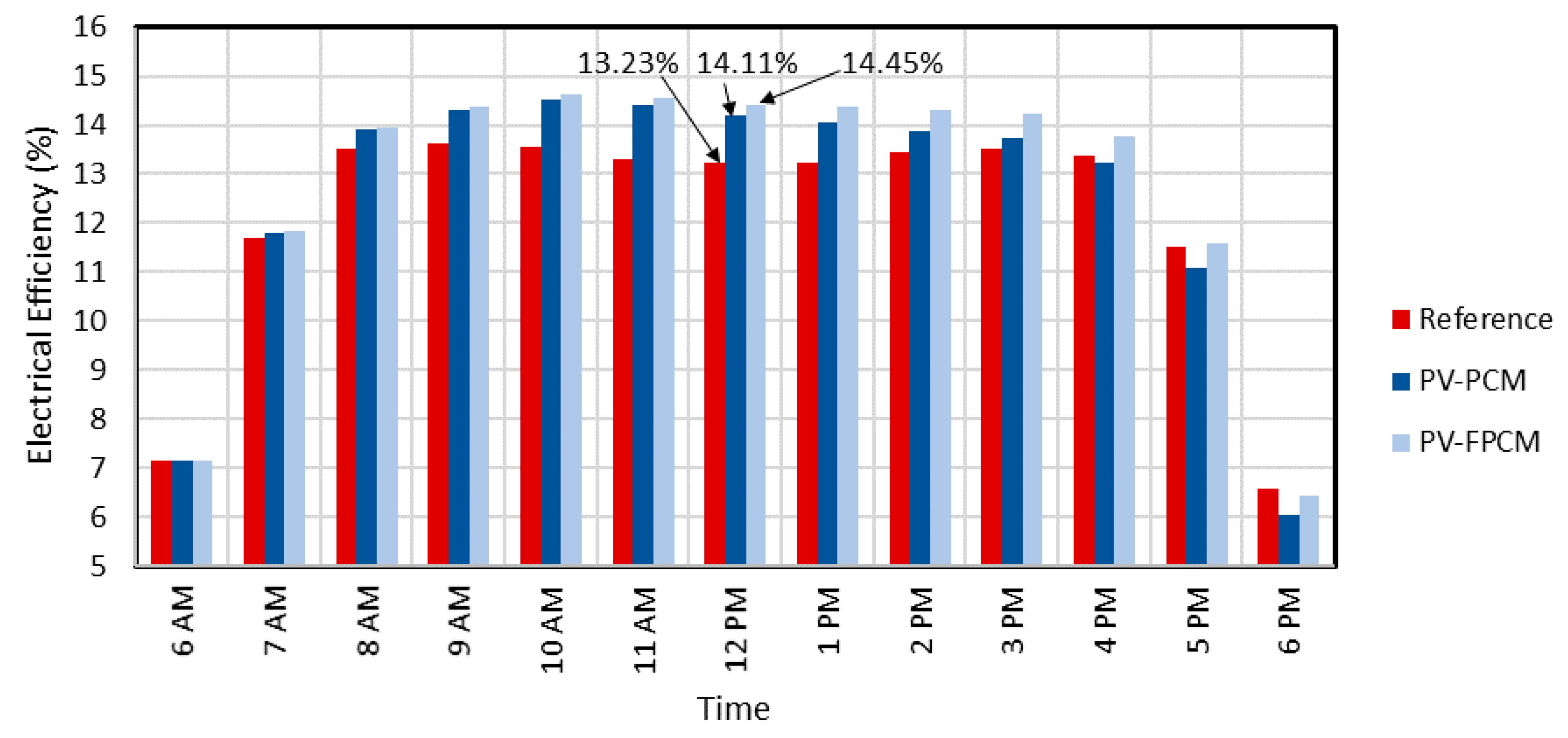
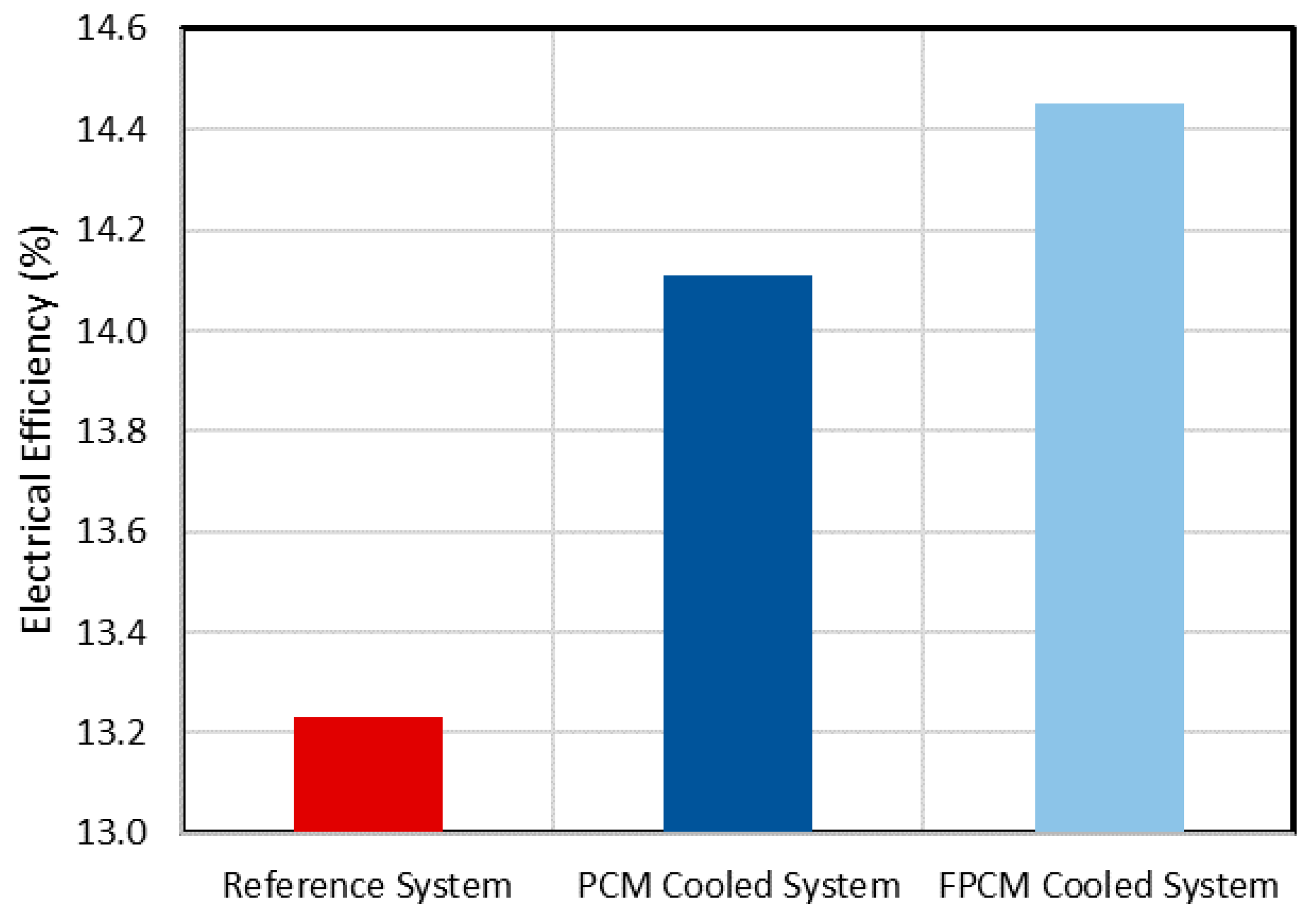
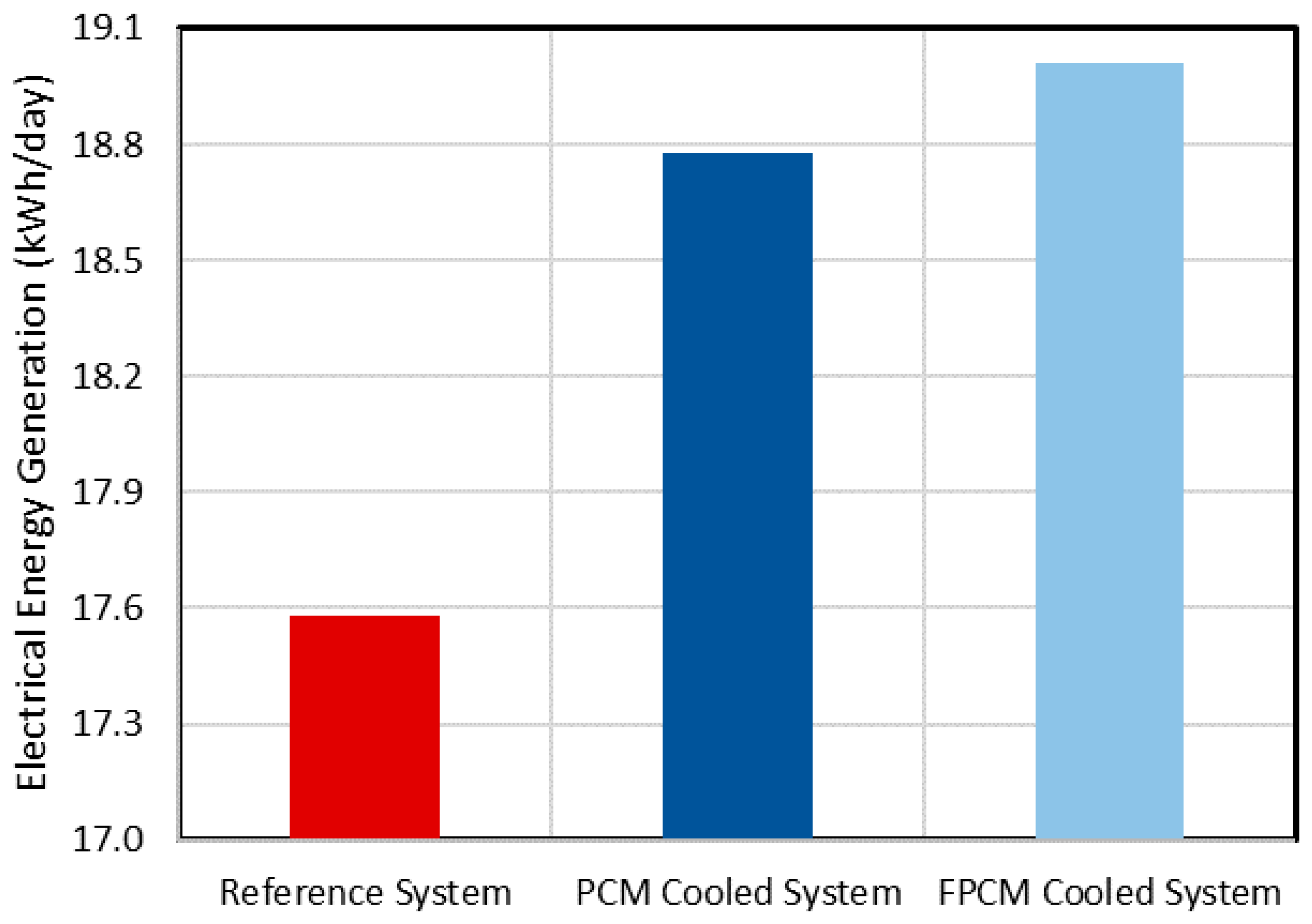
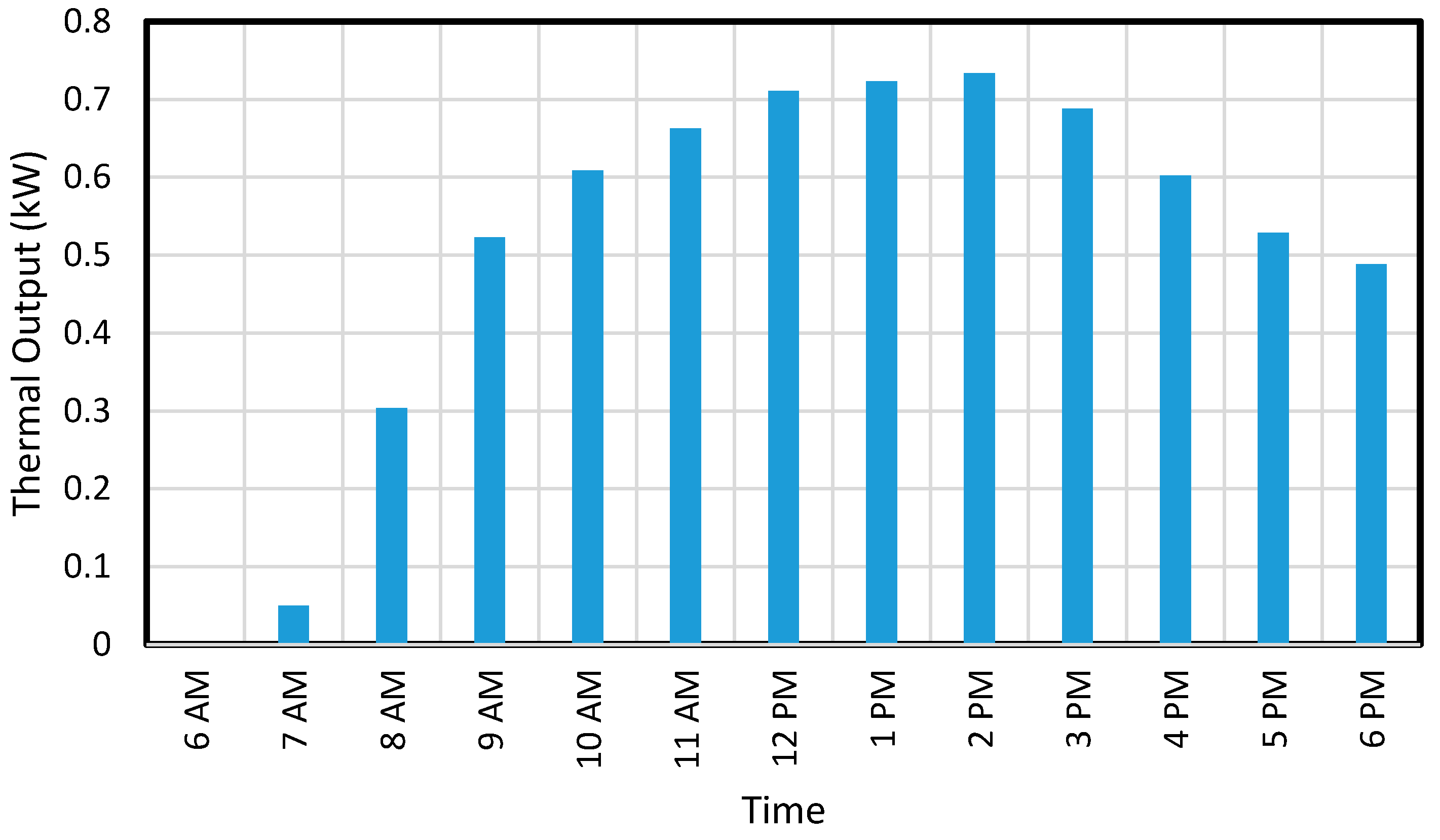
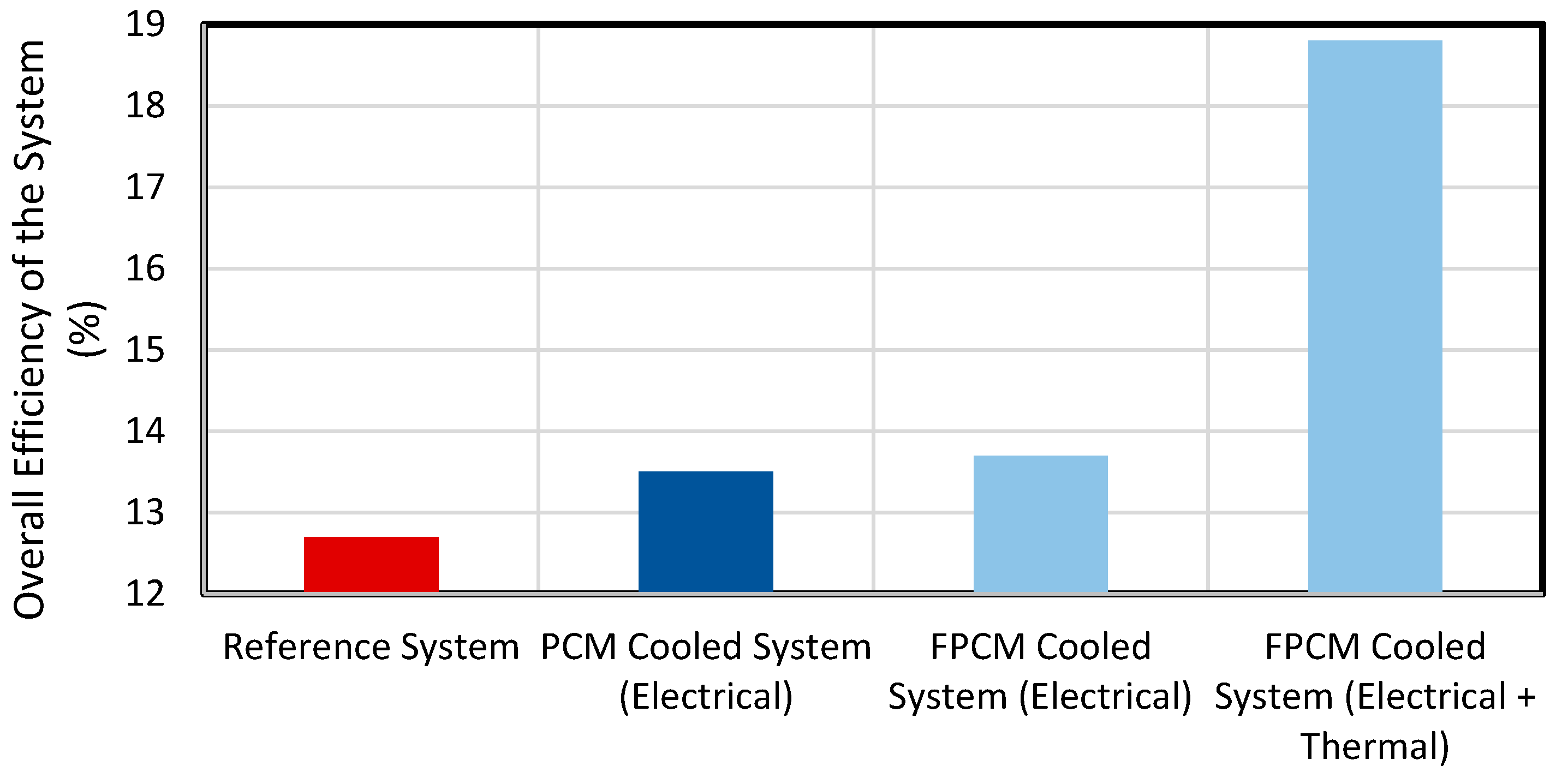
| PCM Parameters | Values |
| Melting Point | ~293 K |
| Latent heat capacity | 190,000 J/kg |
| Specific heat capacity | ~2000 J/kg-K |
| Density | 770–880 kg/m3 |
| Thermal Conductivity | ~0.2 W/m-K |
| Thermal expansion coefficient | 0.001 /K |
| PV Parameters | Values |
| Power rating | 200 W |
| Open Circuit Voltage | 32.9 V |
| Short Circuit Current | 8.21 A |
| Maximum Power Voltage | 26.3 V |
| Maximum Power Current | 7.61 A |
| Container Dimensions | Values |
| Length | 1 m |
| Depth | 6 cm |
| Thickness | 2 mm |
| Tilt | 45° |
| Spacing of fins | 20 cm |
| PCM Parameters | Values |
|---|---|
| Melting Point | 299–301 K |
| Latent heat capacity | 232,000 J/kg |
| Specific heat capacity | 1800–2400 J/kg-K |
| Density | 749–785 kg/m3 |
| Thermal Conductivity | 0.19 W/m-K |
| Thermal expansion coefficient | 0.001 /K |
| Container Length | 40 mm |
| Container Depth | 20 mm |
| Container Thickness | 5 mm |
| Container Tilt | 90° |
| Solar Irradiance | 750 W/m2 |
| Ambient Temperature | 20 °C |
| Time (min) | Observed (°C) | Modeled (°C) | Error (°C) |
|---|---|---|---|
| 0 | 20.0 | 20.0 | 0.0 |
| 10 | 30.8 | 30.9 | 0.1 |
| 20 | 32.4 | 33.1 | 0.7 |
| 30 | 31.9 | 32.4 | 0.5 |
| 40 | 32.6 | 32.1 | −0.5 |
| 50 | 33.6 | 32.0 | −1.6 |
| 60 | 34.3 | 32.4 | −1.9 |
| 70 | 36.0 | 34.0 | −2.0 |
| 80 | 38.5 | 36.8 | −1.7 |
© 2020 by the authors. Licensee MDPI, Basel, Switzerland. This article is an open access article distributed under the terms and conditions of the Creative Commons Attribution (CC BY) license (http://creativecommons.org/licenses/by/4.0/).
Share and Cite
Singh, P.; Khanna, S.; Newar, S.; Sharma, V.; Reddy, K.S.; Mallick, T.K.; Becerra, V.; Radulovic, J.; Hutchinson, D.; Khusainov, R. Solar Photovoltaic Panels with Finned Phase Change Material Heat Sinks. Energies 2020, 13, 2558. https://doi.org/10.3390/en13102558
Singh P, Khanna S, Newar S, Sharma V, Reddy KS, Mallick TK, Becerra V, Radulovic J, Hutchinson D, Khusainov R. Solar Photovoltaic Panels with Finned Phase Change Material Heat Sinks. Energies. 2020; 13(10):2558. https://doi.org/10.3390/en13102558
Chicago/Turabian StyleSingh, Preeti, Sourav Khanna, Sanjeev Newar, Vashi Sharma, K. Srinivas Reddy, Tapas K. Mallick, Victor Becerra, Jovana Radulovic, David Hutchinson, and Rinat Khusainov. 2020. "Solar Photovoltaic Panels with Finned Phase Change Material Heat Sinks" Energies 13, no. 10: 2558. https://doi.org/10.3390/en13102558







